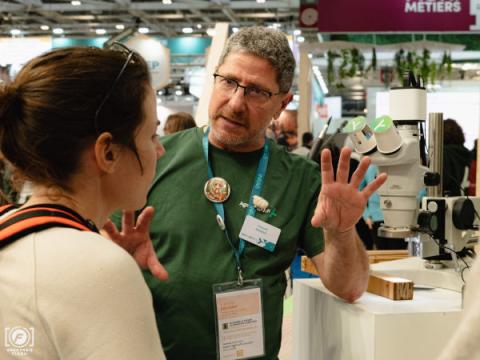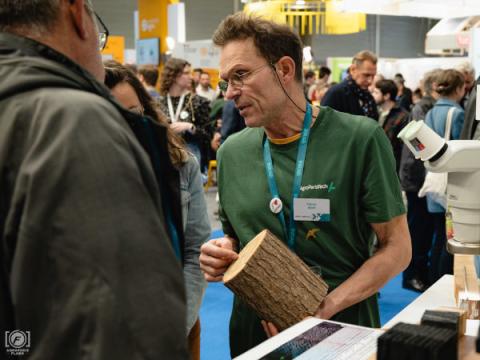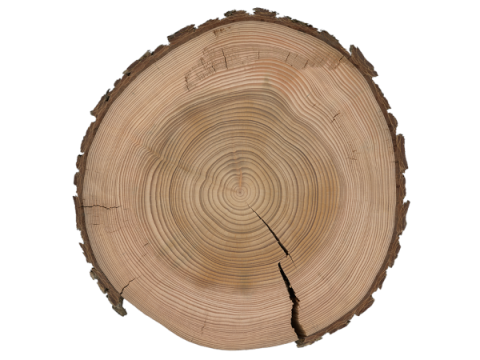
Interview with Vincent Badeau and Patrick Behr
March 05 2025Forest ecology at the heart of the International Agricultural Show
Vincent Badeau, research engineer, and Patrick Behr, research technician at the French National Institute for Agricultural Research (INRAE) in the joint research unit Silva (AgroParisTech, INRAE, University of Lorraine), within the team for the Ecology of Forests and Low-Anthropization Ecosystems (ÉcoSilva) based in Nancy, left their laboratory to meet the public at the International Agricultural Show. They look back on the experience.
VB: I am the manager of the Ecology of Forests and Low-Anthropization Ecosystems (ÉcoSilva) team, where I work mainly in dendrochronology and biogeography. Among other things, we study the distribution area of forest species and their growth in relation to the climate, and then we try to deduce, based on these analyses, how these species will behave in a modified climate.
PB: I collect botanical data related to the forest ecosystem (tree and soil samples, for example). I also work in dendrochronology and dendroecology, which is the study of growth rings and the rate of tree growth to see which environmental constraints affect them the most and how they recover.
What did you propose at the SIA this year?

VB: The bicentenary of the École forestière de Nancy was honored this year at the AgroParisTech stand. We therefore proposed to create activities related to the forest, in particular to explain to the public the role of growth rings and the process of tree development. Visitors were able to use a binocular magnifying glass to observe how the rings are formed: the winter wood and the spring wood; the small rings of dry years and the larger rings of wet years. We brought some equipment to show visitors how we take samples from trees in the forest. We don’t cut slices from all the trees we want to study. We take cores, small samples of wood, with a tool called a Pressler auger.
PB: I explained how and why we take tree cores. Anyone who wanted to, including children, could have a go. This approach allowed them to discover and understand what a tree is. Because I realized that most visitors had no idea how a tree grows and functions.
What do you expect from this experience?
VB: I had already been here a few years ago to present maps of climate change and species presence.
What is interesting about this exhibition is the contact with the public. It gives people who finance research with their taxes an opportunity to see what we are working on in the laboratories and what it is used for. We can reconnect citizens with real science by getting them interested in current research and its applications.
PB: It is also an opportunity to meet and talk with researchers and scientific technicians who work in other fields and on campus.
Why do you think it is important for AgroParisTech to be present at the SIA?
VB: In my opinion, it is essential because that is where science is done, in our institutions: at AgroParisTech, INRAE, CIRAD, the University and the National Forestry Office. They guarantee the rigour and reliability of the scientific information disseminated, unlike the numerous approximations and misconceptions that are increasingly found on social networks.
Being here, is it very different from your daily life?
VB: Indeed, in the laboratories, we are in a fairly confined environment among fellow researchers, doctoral students and students who are there to research and learn. This exhibition allows us to approach an audience without any particular scientific knowledge, who have lots of questions and many misconceptions. It is important to share and pass on knowledge.
PB: And being at a trade fair like the SIA is also very physical, almost more so than coring in the forest!
What did you like most about this experience?
VB: It’s the contact with the public. It’s always very moving to see interested children happy to show that they can count the rings on tree trunks and tell how old it is.
PB: Transmitting knowledge. Because the general public can be worried about major environmental issues such as climate change. We are here to pass on our knowledge to them. For example, the solutions that research is working on today to counter forest decline. And that involves providing information, starting with explaining how a tree grows.


Any message for your colleagues who might be hesitating to embark on the adventure of the SIA?
PB: The experience is worthwhile because we are a reliable source of information. And I believe that our status as technicians makes us more accessible to visitors than that of researchers.


